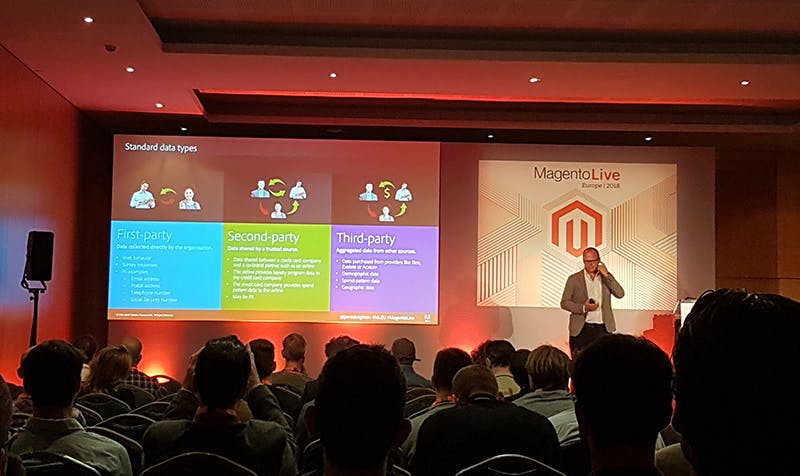Key Takeaways From MagentoLive Europe 2018

Day 2 of Magento Live Europe is well underway…..find out more about the sessions our team is attending today or click the link below to skip to:
Day 2
Session: The Road to PWA
Speakers: Shane Osbourne, Frontend Web Developer , JH
PWAs are the next paradigm shift for the web. We are only just beginning to see what is possible with PWAs.
While many amazing features of PWA are available, the real low hanging fruit is to improve the front end performance of the site. Implementing a PWA isn’t a silver bullet on its own. It is a set of tools and technologies which can bring native app functionality to your website across all devices, not just mobile.
Session: toom + Magento: A Journey to Zero-Downtime
Speakers:
Christian Dornhoff, Head of IT (Cross-Channel), toom
James Halsall, Technical Team Lead, Inviqa
toom is a large company in Germany with over 350 physical stores that needed to be adapted to a Magento framework. With a product management system, a content management system, and a careers system to be integrated, they faced issues with distributed architecture which was resolved using Varnish to handle routing and using Varnish ESI to assemble pages.
To model their 350 stores, they considered using the Magento store models but it massively increased the load time and indexes and made the website unusable. After consultation with Magento, they created a custom market model which also led to setting up the required custom stock and price models, allowing toom to have different prices and stock levels for each physical store.
Magento 2’s dependency injection allowed them to simply replace the Magento stock and price models with their own models. Inviqa also added custom price and stock indexes to increase performance. The existing microservices were able to be utilised to populate the new models.
The indexes contain 35 million stock items and 17 million prices – the query results involved were simply too big for PHP to handle. They were able to address this by using unbuffered queries, but this has its own issues which needed to be dealt with. They were also able to utilise MView to perform partial index updates rather than full index updates to speed up indexing.
toom uses a PIM to control their production information, utilising middleware to import it to their channels (such as Magento) but at 3 seconds per product creation, it would have taken 5 days to import all of their products. Inviqa were able to parallelise the import in order to vastly reduce the time involved in the import process – an 850% improvement in response times, and a 600% improvement in product creation times.
Database upgrades were the major issue in achieving zero-downtime, and the general solution from the community was to use maintenance pages, but maintenance pages mean downtime and toom didn’t want any downtime. Phinx is a platform-independent database migration library that they were able to use via a Magento module to improve the downtime. This means that for their own module updates, they can trigger their own migrations, and only need to use maintenance pages for Magento migrations. They also adopted a policy of ensuring that their DB changes are backwards-compatible to prevent issues.
In order to prevent caching issues when doing a blue-green deployment, they created a new Redis database to handle the caching for the new containers while the old Redis database handles the old containers until they are finished with. This reduced risk and raised predictability.
Key points:
- Magento is extremely customisable
- Big customisations are achievable
- Parallise processes with RabbitMQ
- Custom indexes are powerful
- Always profile your solutions
- Zero-downtime deploys are real
The most important things when looking to achieve zero-downtime are:
- Reducing risk
- Raising predictability
- Not running setup: upgrade when it isn’t required
See also: Inviqa article on how to achieve zero downtime deployments with Magento 2
Session: Understanding & Creating Value in Your Customer’s Journey
Speaker: Anita Andrews, Director, Magento Services, Magento, an Adobe Company
Top 1% of customers is normally 20% of revenue! Grow 1% to dramatically grow business.
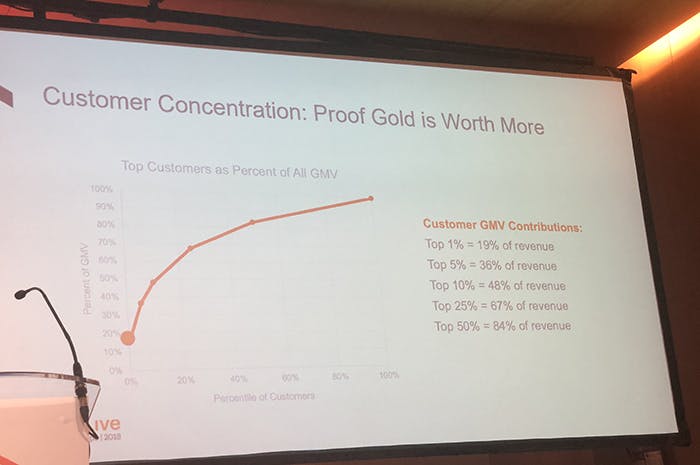
- Customer Scoring – using historical customer experience to score and segment current customers and better predict the future value of prospects once acquired
- Customer scoring is a useful way to make real-time decisions
- Use Data to score customers for example: Frequency + amount (£) they spent + last time they interacted with you
- Can then segment into groups – platinum, gold, silver, etc.
- Then spend marketing effort on high scoring customers and work out expected revenue.
- Measure marketing ROI using Customer lifetime value rather than conversion standpoint
- Campaign data + customer scoring insights = smarter acquisition strategy
- Modern ecommerce businesses must create the experience that pushes your customer over the line
Session: At the Intersection of Content and Commerce: Which Path to Choose?
Speakers: Paul Lewis, Creative Director , Redbox Digital
It’s all about the product – focus on building the product page first, the detail page is key!
Find the right product for the right audience at the right price…targeted at the right market, drives success. The product should be the centre of everything retailers do so it is in the centre of the mind of the consumer being targeted; particularly relevant in fashion retail/fast moving products.
Ecommerce should shine a spotlight on products as if they are on stage (website) with the consumers being the audience through the power of storytelling.
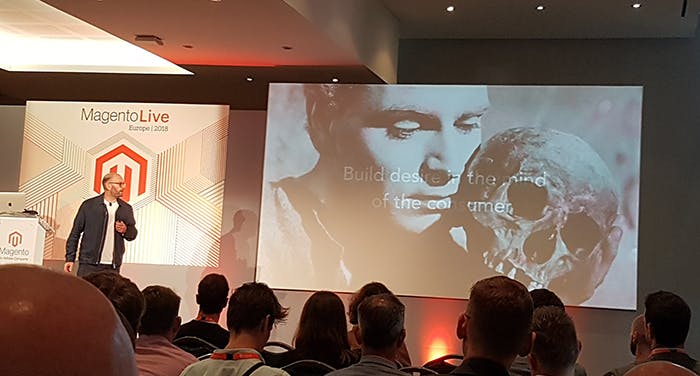
Behind the product needs to be a story! Storytelling has a higher chance of engagement and conversion so build desire in the mind of the consumer with;
– Consistent and coordinated storytelling
– Think wide (multiple devices/channels)
– Create a playground: sites should be fun and engaging in a number of ways
Brands currently telling awesome stories that actively encourage engagement with their own special narrative and unique interactive features; Rapha, Chanel,and Sephora
Key Takeaways:
- Cultivate the ongoing conversation through shared interests
- Share your knowledge and become part of the consumers’ lifestyle space
- Strive to become the hub of that particular interest – regardless of transaction – go for engagement
- Create a world of valuable & interesting content – not silos
- Stories don’t have to be high budget, they just have to be good!
- Build a strong narrative with multiple entry points
- Create a trail of relevant content across multiple platforms threaded together with one engaging story to encourage multi-channel engagement
With the advances in technology and devices, future proofing content is key!
Things to bear in mind when planning content:
- Start planning headless architecture now
- Content modelling needs to be at the centre of planning
- Content that can be broken down into reusable components
- Embrace all forms of content that tell a positive story about your brand and products
- Remember: technology = mechanism content = value
Session: Encory Case Study: Implementing an MVP Project in 8 Weeks
Speakers: Markus Neumann, Managing Director & Founder, mediawave internet solutions GmbH
What is MVP?
Develop quickly, really get to know the customer and their needs v fast, with minimal effort. Get to market fast, test quickly and then optimise.
Learn > Build > Measure (cyclical, ad infinitum)
Continuous delivery: Launch early = learn longer + reduce waste
Frequent releases: each release is a new MVP. Every time you set up your new MVP you learn and hone.
Why MVP?
Technology and customer requirements are constantly changing.
Releasing often allows you to respond quickly to feedback and really hone your offering.
Small incremental changes mean less risk overall; less investment and quicker feedback on smaller risks.
Challenges of case study:
- Fixed budget and fixed deadline of 8 weeks
- Risk management and scope management – took a very active approach, within agile
- Communication – tried to ensure open and transparent communication, frequency meetings and calls during the whole process
Markus has published a white paper on the MVP process which can be requested from Mediawave.
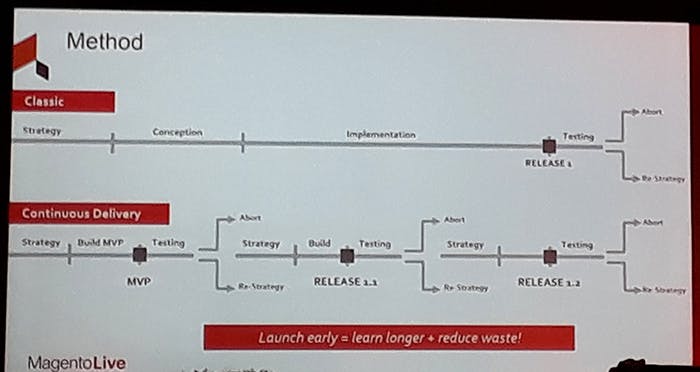
Session: Connected Experiences and The Next Era of Commerce
Speaker: Tash Toothill, Head of Enterprise Sales, Amazon
Voice is changing consumer behaviour.
“Voice represents a new opportunity for consumers and brands alike, redefining the way people research and purchase” Tash Toothill, Head of Enterprise
Why use Amazon Pay?
- Acquire and retain new customers
- Fast and easy checkout process
- Seamless experience with a single login
The Dressing Room (https://www.the-dressingroom.com/) saw sales go up 42% when they implemented Amazon Pay.
AllSaints (https://www.allsaints.com/) saw a 34% uplift in checkout conversions by implementing Amazon Pay.
Access to 300+ million accounts in 170+ customers. 100+ million of these are high-value Prime customers.
Alexa and Amazon Pay can combine the search and purchase process into a seamless experience. Ask Alexa to find a product for you and it can complete the transaction using Amazon Pay without the need for extra devices, inputs etc.
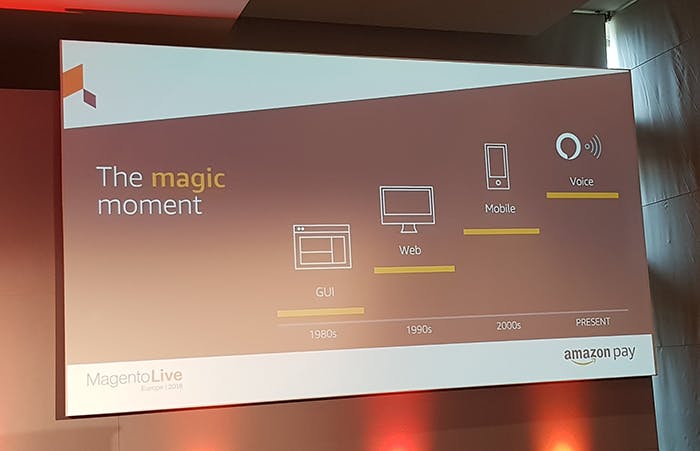
Session: Integration Strategy with Order Management
Speakers:
Felix Delval, Architect, Magento, an Adobe Company
Elena Kolodyazhna, Technical Architect, Magento, an Adobe Company
Magento Commerce Order Management is a modular cloud-based system designed to provide centralised inventory, order, and fulfilment capabilities for a consistent omnichannel experience for your customers.
It can be used to: add in-store pickup; ship between stores; provide an “endless aisle” to customers; coordinate across sales channels, brands, etc; and more. If used correctly it may be able to replace several other platforms currently in use by Magento stores and provide a smoother experience to both store owners and customers.
As a Software-as-a-Service solution, it can be utilised by installing the Magento Order Management Connector extension, but this does require Magento Commerce. It can also be utilised as a custom integration. Its main role is Omnichannel Order Fulfilment, providing advanced omnichannel and fulfilment capabilities, with the ability to be customised by integrations.
The two versions presented were for a direct connection between Magento Commerce and Magento Order Management, or using a custom logistics platform to integrate between Magento Order Management and Warehouse management software.
It was suggested that if you are looking at scaling or otherwise concerned about performance that it may be better to integrate your warehouse integration with Magento Order Management via a custom solution hosted elsewhere than to integrate it directly with Magento. There is also the option of using an integration platform.
There are twenty live platforms and twenty in-progress platforms. The Magento Order Management system can be used with any system via custom integrations, not just Magento.
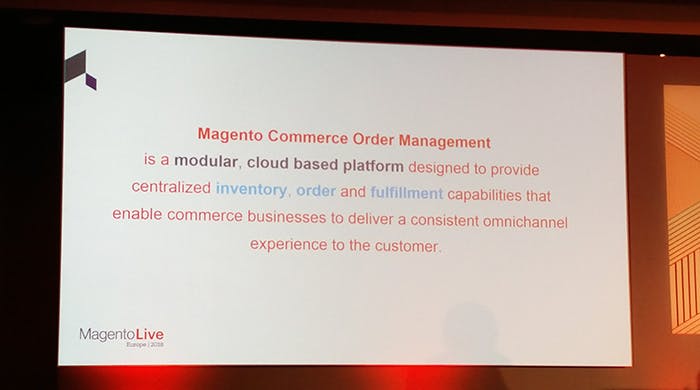
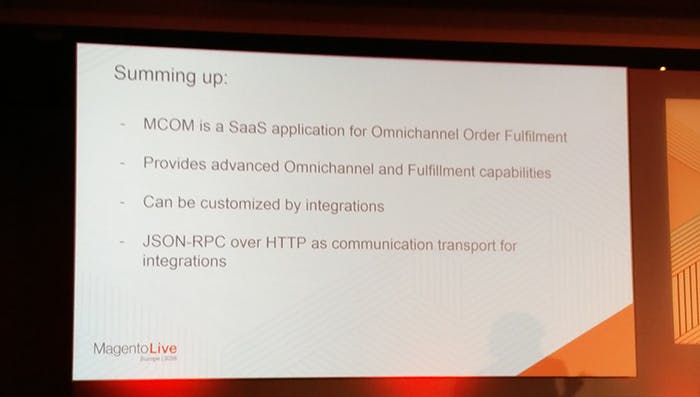
Session: The eCommerce Journey of a Traditional Publisher
Speaker: Kirsten Morrison, Head of Digital, D.C. Thomson
Traditional Publishing sector has been really challenged so diversification has been a big focus. Looking at Data layer and ecommerce. Personalisation very important – helping editorial colleagues focus on content that is interesting to users.
Exploring what they do to make every piece of content sweat harder. Change the skillset that they currently have – in-house or upskill.
B2C
- Affiliate marketing/content
- Partnerships
- Transactional Shops
B2B
- Magento builds for other publishers/businesses
- Relationship with medium sized business and experienced in ecommerce for 5 years so moving into offering this as a service.
Session: Osprey London – Leveraging Magento & the Ecosystem for Growth
Moderator:David Wise, Director Channel Sales EMEA, Magento, an Adobe Company
Speakers:
Skip Fidura, Strategy & Insight Director , dotmailer
Ben Jones, Ecommerce Manager , Osprey
Sarah Rees, Customer Success Manager , Nosto
Paul Rogers, Solution Architect, Klevu
Before Magento, Osprey used a bespoke CMS website that caused issues to update due to bespoke complexities and limitations. Osprey were unable to invest in customer acquisition due to the website being a barrier to customer goals.
The case had to be made to the owners of Osprey that growth could be achieved with an improved ecommerce store. The move into new technology began with the need for a platform that could support growth, and be reliable and robust. Osprey were selective with decisions to ensure that growth was as efficient as possible.
Email marketing was essential to Osprey so they brought in dotmailer. Dotmailer assisted with the least amount of disruption during the move.
Initially the Osprey/dotmailer partnership focused on;
- Re-engagement: lack of communication to bring them back to the site and convert so a re-engagement campaign was introduced.
- Abandoned Cart: this was a manual process so dotmailer implemented an automated process
Omnichannel is now the way forward for both Osprey and dotmailer. The most successful way to work with a 3rd party is a collaborative one. Time is a precious resource and efficiency is essential on both sides of the fence. Automation, wherever possible, is a massive part of this efficiency drive, saving the Osprey team precious time.
Omnichannel Essentials;
Initiate a touchpoint with the customer and ensure this is a 2-way process as the brand is seen from multiple touchpoints. This creates the need for consistency and relevancy, particularly across devices and channels.
Nosto was able to pick up the behavioural and transactional data to enable personalisation, getting the right content and messaging to the right people at the right time. This helps the online experience reflect (as much as possible) the bricks and mortar retail store.
Personalisation needs to be seamless and understated, Nosto’s algorithms facilitate this.
Some surprising results were discovered during testing of the personalisation with Nosto;
When people are checking out, there are “you may also like” options. It was expected that users would add smaller/lower value items but it was more effective to display higher value items that are more aspirational which worked better. This allowed for adjustments to be made and easy to test with Nosto to increase average order value and increase revenue.
Working with Klevu, Osprey will always have category based journeys but search is the next area of focus to allow users to create their own curated journey; Klevu is driving this process. There is a level of intent with search and this has shown positive results in testing, compared with a category based journey.
Klevu are including machine learning and optimising results based on user behaviour. They are hoping to integrate more with Nosto and the data gathered to optimise Osprey’s user journeys even further with the inclusion of machine learning to provide more contextual results to site visitors and increase conversion rates.
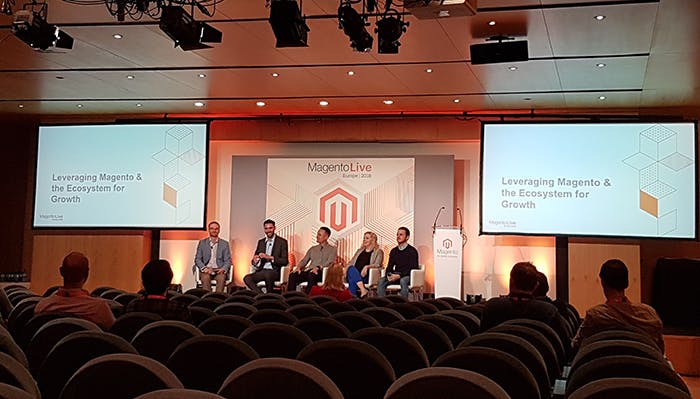
Session: The State of Progressive Web AppsModerator: Eric Erway, Senior Product Manager, Magento, an Adobe CompanySpeakers:Jamie Huskisson, Founder, JHRowan Merewood, Developer Advocate, GoogleJamie Maria Schouren, Revolutionist, Deity
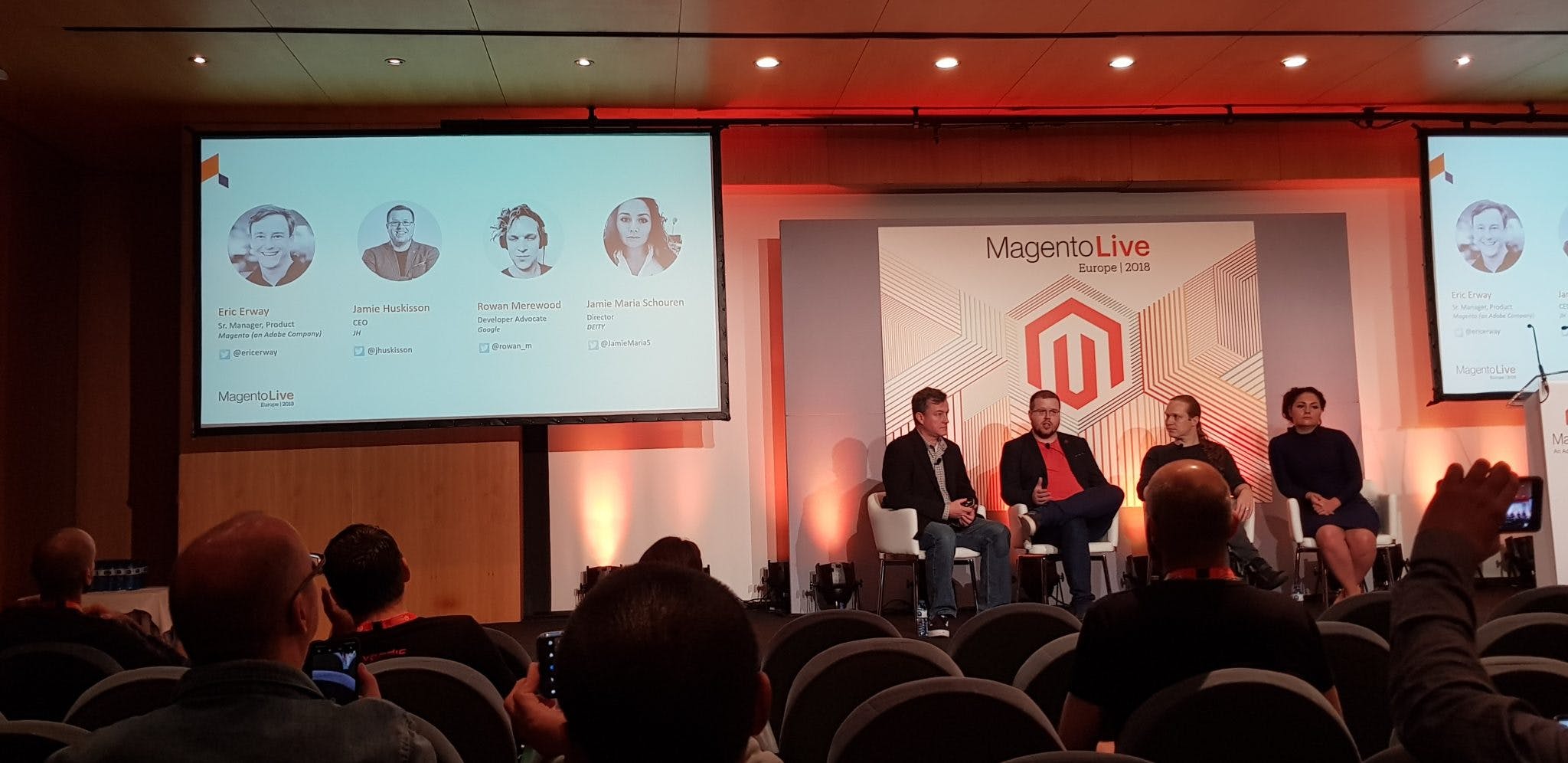
What has changed in the last 12 months:
- Progressive Web Apps have matured incredibly quickly
- Awareness has increased among developers and clients
- No longer looking at features on their own, focus is now on customer experience
- No longer just a set of tools
- Ecosystem is growing rapidly. Support from Google, Microsoft and Apple.
Session: The Road to Migration with HallhuberSpeaker: Stefan Willkommer, CEO, TechDivision
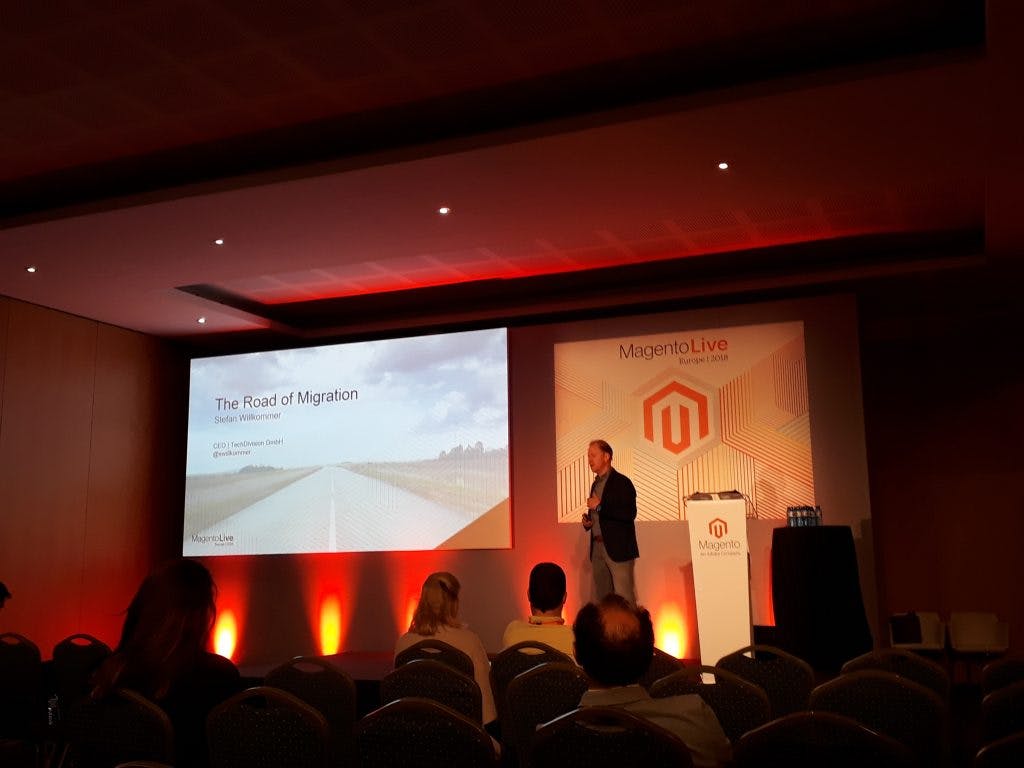
Migration from M1 to M2 has been one of the biggest topics of the past couple of years.
Ideal migration strategy:
- Build a 3yr digital strategy
- Rescope & descope
- Go for mvp (M2 out of box) with an agile approach
Rescope and descope is the key step – do your housekeeping! What is the business case for each of your extensions? Look at Magento roadmap and align with it. Determining your MVP should be based on business case and ROI. Use moscow to prioritise.
It doesn’t always go that way though!
The challenge: Mature site (6 years), huge database, large number of integrations.
How did they do it: 13 devs on the project! 14 month project (not MVP). 12000 hrs worked. 33 vendor extensions. 880 user stories; 2481 pages printed out! 20% of the project was PIM integration. 20% agile and PM time.
Burndown chart is the only chart that gave realistic timeframes. Project scoping continued for the first 2 months of the project (while dev was underway).
Data migration:
- The migration tool isn’t out of the box – takes tweaking and honing.
- Reached database schema early in the project and then did nightly migrations.
- Used an intermediate migration database; migrated from m1 to migration DB, imported from 3rd party systems into production, then cherry-picked data over into production from migration DB.
- Was the largest migration project they had ever undertaken – they learned a lot from it and if they could do it again they would have employed stricter PM approach and would have pushed back on the number of features and tried to get the client to focus on an MVP.
Session: Magento Community Driven Project: Asynchronous & Bulk APISpeaker: Oleksandr Lyzun, Magento Technical Team Lead, Comwrap
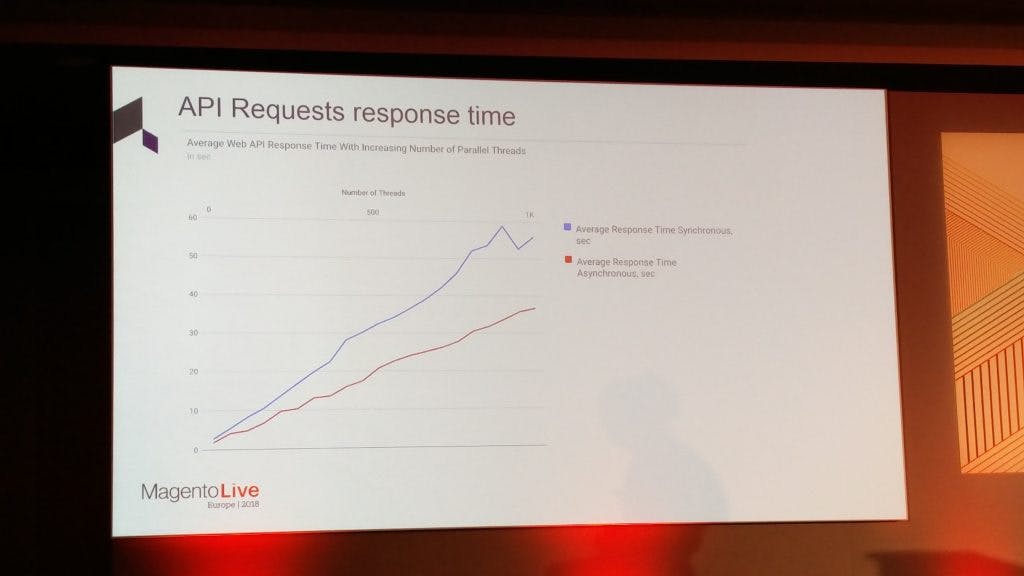
Asynchronous APIs allow external systems to use the Magento 2 API to provide updates without slowing down the main Magento processes. The more incoming requests you have, the slower the overall system will be as it tries to process all the requests. What running API requests asynchronously does is allows those API calls to be run when the server is quieter or on a schedule rather than requiring them to be run right then.
Changing to use the asynchronous API is as simple as adding “/async” to the front of your API requests.
The bulk API allows external systems to do bulk requests and submit many things at once rather than submitting them one at the time. Bulk requests are always processed asynchronously and can be enabled by adding “/async/bulk” and changing your requests to add the multiple request parameters.
The asynchronous API currently supports PUT, POST, and DELETE requests, while the bulk API currently only support POST requests.
External systems will be able to check the status of operations through the use of new GET requests in the standard Magento 2 API.
Using the asynchronous API has reduced the response times of API calls and massively reduced the number of error responses caused by server overload.
It’s been used on a real-world website where a massive product import was done via the asynchronous API which had 800,000 API requests happen one day with no noticeable slowdown on the website and no errors with the import being noted. There was no need to adjust the server or otherwise prepare for the import and that was a massive change from the normal 20,000 daily requests.
Developers are also able to develop their own asynchronous and bulk operations, and the system can be used with Magento Message Queue (soon coming to Magento Open Source as well as Magento Commerce).
These features will be available in Magento 2.3, possibly in 2.2.7 onwards, and have been added as a result of contributions and work from the Magento Developer Community, meaning that they will be available in both Magento Open Source and Magento Commerce.
Ongoing improvements to make it smarter, faster, and also to make the current CSV import asynchronous which would also make that more reliable. Current testing with using Redis instead of the database to store requests shows another improvement in response times.
Session: Mobile Conversion Optimization: Results From the Community Global StudyModerator:Rob Long, Evangelist, PayPalSpeakers:Zee Aganovic, Founder, President & CEO, HiConversionJanak Kika, Head of Accounts, JHMatt Parkinson, Managing Director, Gene Commerce
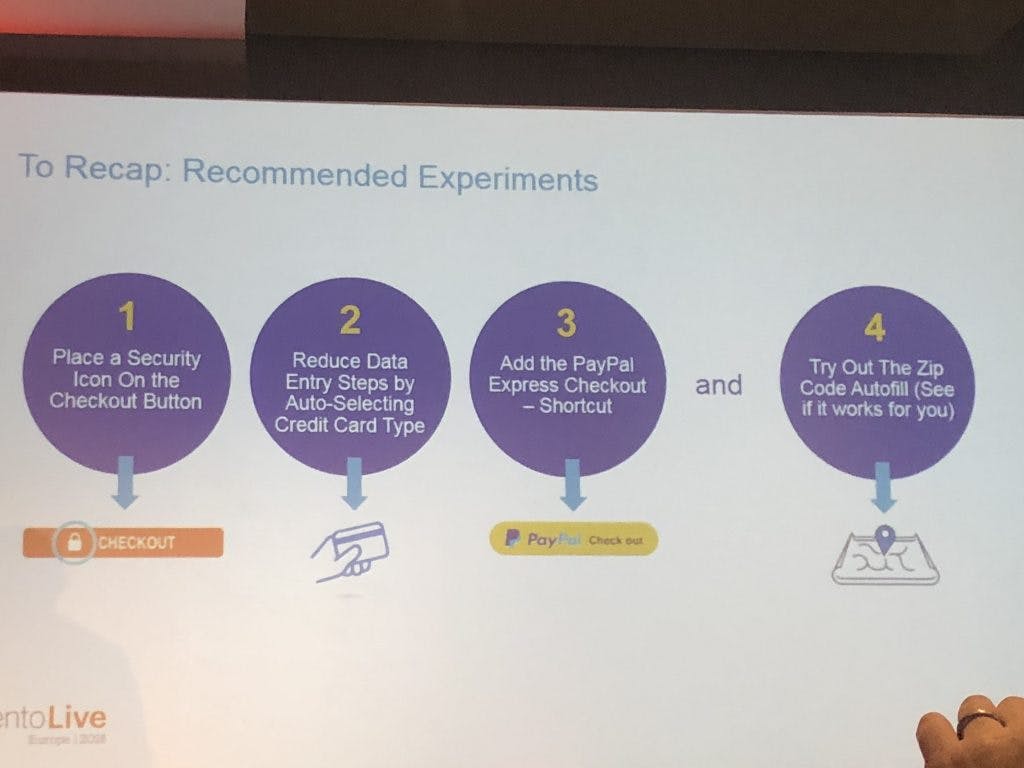
Magento community of partners is working on an initiative to close the mobile gap in sales. Spend on mobile is still dramatically smaller than desktop (44% less). Every element of the checkout funnel is under review and being tested.
Key metrics and supporting data:
- Focus on RPV (revenue per visit) but also looking at
- CR (Conversion rate) &
- AOV (Average order value)
63 merchants studied with $10m revenue tracked. The following tests were carried out:
- Place security icon on the checkout button. Enforce trust. Security lock image vs cart image is the only difference but a big uplift in results. On phone, RPV increased by 17.37% and AOV +20.2%. Explore the impact of trust badge placements. Demonstrates that retailers may not have to redesign the whole site to get a big benefit.
- Reduce Data Entry Steps by Autoselecting Credit Card Type. But note and test differences across device type. There were negative results on phone with RPV down by 7.99%. up by 21.53% on desktop.
- Add the PayPal express checkout (move this higher in the checkout funnel on the cart). Mobile uplift by 8.72% in RPV. Also, an increase in CR and AOV. Improvements in results across all devices. AOV also increased which shows that customers still browse.
Unexpected result:Postcode autofill did not improve RPV but main results were taken from USA. RPV down -0.88% on phone.
More information about the study and how to get involved can be found here: mobileoptimized.org/home/
Day 1
We’ve arrived for the first day of MagentoLive Europe in the beautiful Barcelona! There are lots of exciting sessions on today’s schedule, covering topics from “Magento 2.3 Updates” to “Powering Your Website Content with Magento PageBuilder”. We didn’t want our readers to miss out so we will be live blogging from the event, giving you the key takeaways from the sessions we attend.
Key takeaways from Magento Live Europe 2018 (most recent sessions 1st)
Session: Integrating Magento with Adobe’s Experience Cloud
Speakers:
Martin Buergi , Senior Product Manager , Adobe
Salvador Morales Olaso, Consultant, Adobe
Now that Adobe have integrated Magento, they’ve managed to integrate the Adobe Experience Cloud with Magento in only a few months. My understanding is that they are probably leveraging the Magento API to fetch the data allowing it to be fairly agnostic of any required server software.
No special software is needed server side, and Salva took us through the exercises created to show people how to get used to working with the software used to pair the AEC with Magento, as well as showing a working example of the software not only being able to fetch data from Magento but manipulate it to show discounted rates and information.
In the right hands, this could be a really powerful tool for any website, but especially any site that intends to get highly involved in social experience sharing.
Session: See it, Wear it: How EGO is Using UX Strategy and Flexible Payments to Accelerate its Purchase Journey
Moderator: Ryan Leffel, Senior Director of Customer Experience, Corra
Speakers:
Lindy Crea, Senior Commercial Manager for Global Partnerships, Klarna
Haroon Hussain, eCommerce Manager, Ego Shoes
Usman Riaz, CEO, Ego Shoes
For Ego, customer retention was very poor on their first website. They needed to look at their customers to improve the conversion rate – specifically for mobile.
Mobile is 80% of traffic and 75% of conversions so content needed to be tailored to small device sizes and needed to be fast to load!
They introduced shoppable content on Instagram and incorporate using images from Instagram into a gallery of products on the website. This offers consistency and improves conversions.
Klarna Buy Now Pay Later appeals to their target market and helps push sales. Klarna also offers one-click repeat purchase. Ego has seen a 31% increase in conversion rate since rolling out Klarna. Now 17% of customers use pay later option (especially in week 3 before payday!)
Pay later customers have a 20% higher purchase frequency than customers that don’t pay later.
The ability to pay later or “try before you buy” gives the same experience as customers would have in the shops. Returns have increased, but the increased revenue has made it worthwhile.
Session: Powering Your Website Content with Magento PageBuilder
Speakers:
John Hughes, Head of Magento, Fisheye
Olena Tkacheva, Sr. Product Manager, Magento, an Adobe Company
Live drag and drop interface in the admin; really easy to use and very visual. The interface is deliberately non-technical and uses friendly language so that anyone can create a page in minutes. It’s so easy to use they didn’t even feel the need to create a user guide!
Adjustable column grid means the page will always be responsive. Colours and fonts are inherited from the theme so that the site remains consistent.
You can include products in the page – featured product slider, for example.
Page builder can be used on category and product pages too! You can use it to really showcase product content.
You can create CMS blocks separately and then insert them into pages using page builder – ideal for content that you want to repeat throughout your site.
You can insert content from 3rd parties into a page using page builder, for example, an Instagram feed
Benefits to Magento Partners:
- Less involvement for devs; empowers store owners to take ownership of their content and how it is presented
- Can extract flat html and reuse the content across to other systems/platforms
Page builder is available now to Magento partners who have signed up to early access.
In Q4 it will be available to some merchants and it will be available to all Magento Commerce merchants in Q1 2019.
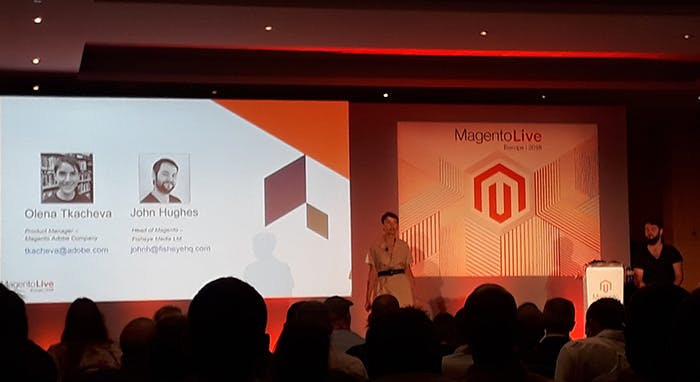
Session: Features of the Funnel with Google
Speakers:
James Antisdel, Technical Solutions Manager, Google
Rowan Merewood, Developer Advocate, Google
Jose Ugia, Developer Programs Engineer, Google Pay, Google
Mobile conversions suffer massively due to the time it takes to load a site, connection issues, as well as the volume of taps required to complete a checkout.
Google has the following features to help retailers create a frictionless experience;
1. Lighthouse
The quickest, easiest way to improve load time on ecommerce sites is the optimisation of images due to them being so image heavy. Lighthouse, although not new, has been improved and lets you easily see what images are causing issues, presenting workable opportunities for optimisation
2. Service Worker
This works via javascript and ensures users remain on the site when there are connection issues. Trivago has implemented a Service Worker feature whereby a puzzle is presented to the user when the connection fails. This keeps the user on site and since implementation, 67% of users remain on the site and continue their journey: losing connection doesn’t mean losing the customer
3. Google Pay
On average 100+ taps are required to complete a mobile checkout, Google Pay reduces this to approx 4 taps. This is available in 60+ countries and is usable in different browsers and operating systems. Due to the simplicity of this, Google Pay allows you to future-proof the site in preparation for voice-powered transactions.
Session: Keynote
Magento is changing for the better; more capabilities and more ways to grow your business with the help of Adobe. The new partnership is intended to help win the customer journey as the customer lives in a digital world.
Content must be relevant, consistent, personalised throughout all channels, immediate and frictionless – Magento is making this happen through digital transformation with Adobe.
Adobe make every experience personal and Magento make every moment shoppable; it is this combination that will generate growth and success.
Exciting times ahead for the future of ecommerce with the Magento and Adobe partnership with continued investment in all facets of both platforms. This is particularly relevant with the integration of the Magento Experience Cloud into the Adobe Experience Cloud, including;
- Adobe Advertising Cloud
- Adobe Marketing Cloud
- Adobe Analytics Cloud
- Magento Commerce Cloud
Unifying behavioural data from Adobe with the transactional data in Magento, provides a 360 degree view of the customer.
Other key announcements:
Magento Payments – more info here
Magento moving into payments that will improve conversions while reducing the operational complexities of running an online business.
Mobile Optimisation Initiative – more info here
Magento Introduces the Mobile Optimisation Initiative for Merchants with a community-driven project with PayPal, HiConversion and 15 system integrators, tackling the mCommerce gap.
Delivering Superior Merchant Experiences – more info here
The latest release of Magento Commerce to deliver best-in-class B2C and B2B shopping experiences that accelerate sales.
Developer Experience Enhancements – more info here
In addition to significant merchant experience advances, the latest release of the Magento platform makes powerful new tools available, designed to enhance the developer experience. A superior developer experience (DX) is essential to their ability to deliver on merchant expectations in a timely and efficient manner.
Session: Magento 2.3 Updates
Speaker: Olga Kopylova, Lead Architect, Magento, an Adobe Company
A bundle of new features being added to Magento 2.3, both immediately and in the future:
- GraphQL is going to streamline building queries and make the process smoother for developers and reduce the need for clunky backend code. Will be available for checkout in the future.
- PWA is going to gain some in-built support from Magento, though details were a little thin.
- Database setup is being simplified to make it better and clearer. This is going to make it much simpler to build new database tables and to update schema and data going forward.
- Asynchronous web APIs are being added so that API requests can be done without risk of holding up the frontend Magento process.
- The message queue has been moved from Magento Commerce to Open Source
- Extra validation has been made available for page requests to make the system more secure and safer and prevent people trying to access elements in the wrong fashion.
- Elasticsearch support is being natively added to Magento Open Source, along with Elasticsearch 5 support. It will become the default Magento search engine in the future.
- PHP 7.2 support has been added, and PHP 7.0 support has been dropped.
- MSI or Multi-Source Inventory has been added, meaning that you can log your inventory as being in different warehouses. Magento will reserve the products sold rather than directly reducing the quantity allowing you to determine where the stock is reduced from.
- The WYSIWYG editor is being updated to the latest version – hopefully, this will remove the bugs with adding images that we’ve seen!
- A new Page Builder is being added to Magento Commerce as an alternative to the WYSIWYG editor, and will be available as a paid extension for Magento Open Source. It’s still in progress but will allow you to get a much better idea of what your page will look like, and arrange components so it’ll be much easier to get content pages looking the way you want them to. An early access program and beta will be available to selected Magento partners and merchants.
- Two-factor authentication support is being added to the admin panel to improve security! Google Recaptcha is also being added natively to both customer login and the admin panel.
Other than that, the quality of the code is generally being improved with the intention of removing legacy code like the Zend Framework in the future.
Magento 2.3.0 is available in beta right now for any developer that wants to try using these new features today.
Session: Magento 2.3 Commerce Features Lightning Talks
Speakers:
Mark Brinton, Sr. Technical Product Manager, Magento, an Adobe Company
Corey Dulimba, Senior Product Manager, Magento, an Adobe Company
Eric Erway, Senior Product Manager, Magento, an Adobe Company
Chris Hedge, Director of Product Management, Magento, an Adobe Company
Olena Tkacheva, Sr. Product Manager, Magento, an Adobe Company
PWAs are the future; speed and SEO focus, front-end dev tools (studio) focus on UX and treating the dev as a user.
Pagebuilder is really cool and will make content entry super simple and easy for anyone to use! Olena gave a really informative live demo; the drag and drop content building interface and the live preview in the admin panel were particularly impressive!
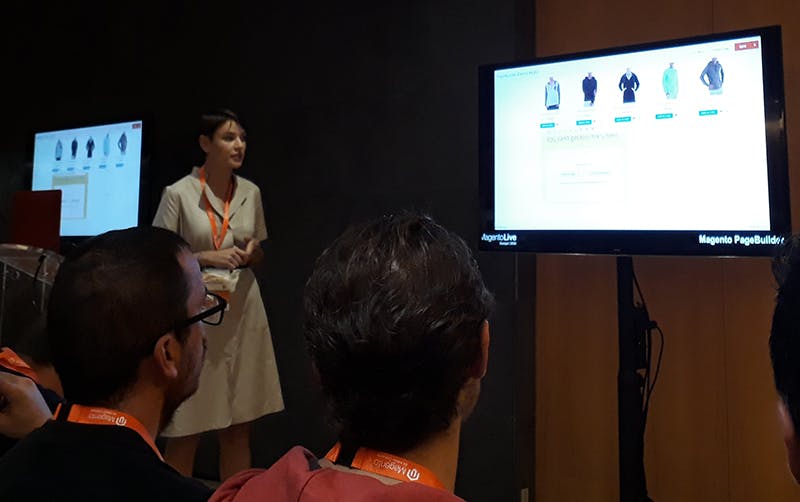
Session: Intelligent Retail: Delivering AI-Driven Shopping Experiences from Prospect to Purchase – Case Toolstop
Moderator: Isaac Moshe, CMO, Nosto
Speakers: Neil Bruce, eCommerce Manager, Toolstop and Rory Gilmore, Technical Solutions Manager, Nosto
Key points from Isaac Moshe: Huge delivery gap between what level of personalisation retailers believe they offer (80%) and their customers perception of the level of personalisation they offer (8%).
Transactional data only accounts for 1.6% of data on an ecommerce site. 98.4% is behavioural data. This is a gold mine. Number of visits, intentions, buying preferences. The true value of behavioural data is to leverage it within a real-time feedback loop. Use AI to track behavioural data and update the shopping experience for a customer in real time.
Main take away point: You can offer the same level of personalisation as Netflix by leveraging behavioural data through AI, not just transactional data.

In the past browsing behavioural data only became available at the end of the experience but the true value is in real-time feedback loop.
Examples of personalised experience on homepage:
- Navigation bar changed in categories with higher affinity to customer
- Banners targeted
- Geolocation delivers relevant currency
- Brand logos displayed based on interest
- Personalised recommended products
- Relevant videos and content
Reduces the need for unnecessary discounts. (AI will figure out who is discount sensitive)
Session: Brewing Up Success by Upgrading to Magento 2 in 3 months!
Speakers: Mark Roberts, Co-Founder, Beer Hawk and Lewis Sellers, Founder, Pinpoint
Migration from M1 to M2 in only 3 months! Absolutely fantastic achievement. They hit the 3-month deadline (+3 days haha).
Key points:
- Detailed scoping and shared, solid understanding of objectives is key
- Focus on MVP to hit a tight deadline, features can be added further down the line
- When working with multiple teams, across organisations, breaking down comms barriers is key; try to work as one team!
- Accept bugs as inevitable and launch anyway
Session: Elite Bug Squashing
Speaker: Tony Brown, Technical Director, Space 48
Every developer needs to take note here! Everyone has something to learn!
Key points:
- Use the right tools for debugging
- Research the problem
- Level up your debugging
- Don’t be afraid to ask for help
- Establish a culture of learning
- Get a copy of the slides!
Tony Brown gave a really solid talk on debugging and how to level up and become an expert. I’d highly recommend any developer check out his notes on the topic!
Key points are to use the right tools for the job, research the issue, eliminate as many causes as possible, and ask for help when you need it! Always keep learning!
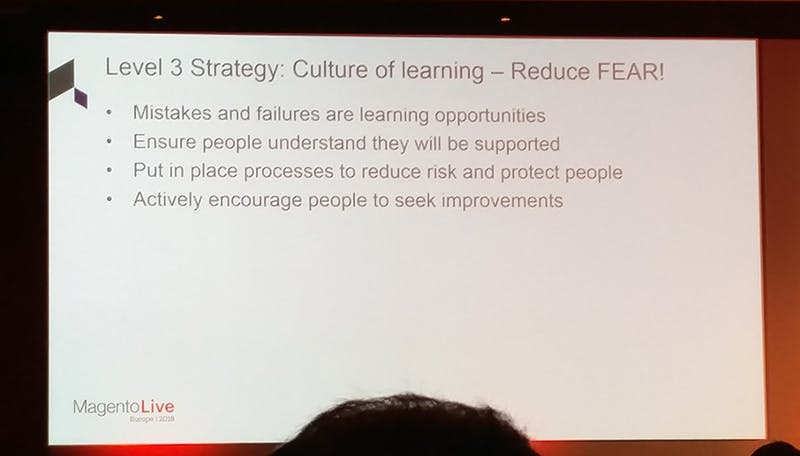
Session: The Omnichannel Strategy for B2B2C
Speakers: Erwin Idelenburg, COO, Youwe and Rob Wiek, CEO & Co-Founder, Youwe
Erwin Idelenburg, COO and Rob Weik, CEO & FOunder of YouWe give an insightful case study presentation of Quooker and how the brand has utilised Magento for omnichannel to establish a competitive eCommerce presence.
There are many challenges faced by Quooker given its multi-national target offering; B2B in some country, direct to consumers in others, multi-country marketing support and experience Vs conversion to name a few!
Replatforming to Magento was the ideal solution for now and the future due to the following features;
- Magento 2 out of the box for B2B features
- Magento page editor (previously bluefoot editor)
- LOTS of marketing tools available out of the box
- Many 3rd party integrations available
- Mobile-friendly support (PWA)
- Advanced SEO
- An increasingly customer-centric shopping experience
- Multilingual and multi-currency support
Magento 2 has made leaps and bounds where out of the box features are concerned, making many more channel targeting options accessible.
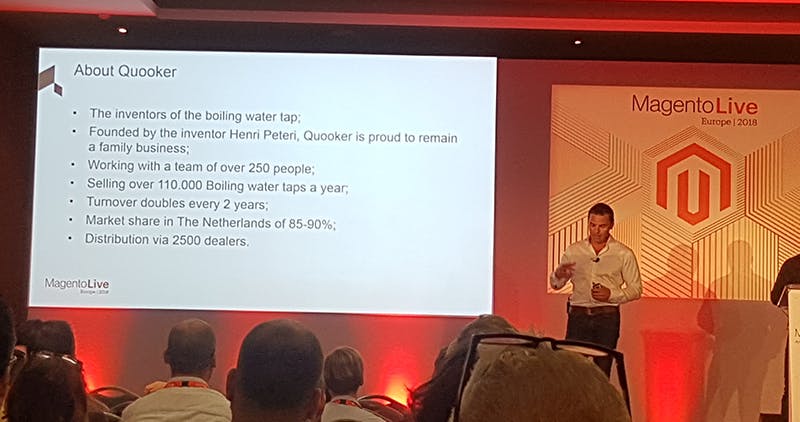
Session: Implementing a Project Effectively on Magento Commerce Cloud
Speakers: Billy Gilbert, Cloud Tech Ops, MTS1 Engineer , Magento, an Adobe Company
Good general session for people getting started on Magento Commerce Cloud. They explained the technologies involved, the processes and workflow required, and some of the differences between the Starter and Pro plans.
If you’ve built a Commerce Cloud site already, it probably wasn’t that useful a session, but if you were unsure on the basics, help is available! Check the DevDocs which are being updated all the time and join the Magento Community Engineering Slack which has a dedicated Cloud channel where you can get assistance from the community and Magento engineers.
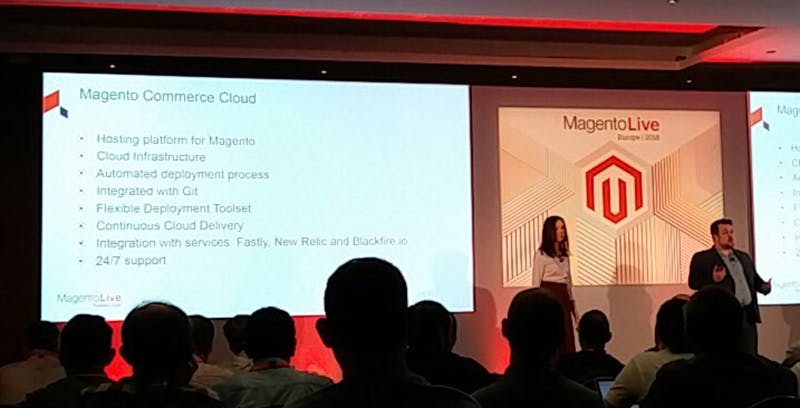
Session: The Personalisation Spectrum
Speakers: Jamie Brighton, Sr. Manager, Product Marketing, AEM & Target, Adobe
Key points made by Jamie Brighton are that;
Data and content MUST live and work together to enable the retailer to offer the consumer relevant experiences.
2nd & 3rd party data is key to helping support the relevant experiences by using the technology available.
The unknown consumer can tell us much more than we think – geolocation, the fact they are a 1st time visitor, the referring URL, referring search term, their operating system and browser to name a few. This information can be used to turn the initial contact into a nurtured lead who will provide more personally identifiable information. This consumer can then be driven down a funnel that will allow for up and cross-selling on multiple channels and devices going forward.
Long story short, data is KEY!
